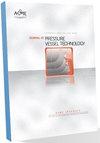裂纹形状理想化对拉伸载荷作用下共面表面缺陷相互作用的影响研究
IF 1
4区 工程技术
Q4 ENGINEERING, MECHANICAL
Journal of Pressure Vessel Technology-Transactions of the Asme
Pub Date : 2022-06-14
DOI:10.1115/1.4054811
引用次数: 0
摘要
工程关键性评估(ECA)指南包含评估缺陷相互作用的规则。主要缺陷尺寸(深度或高度和长度)通常通过缺陷理想化程序来表征,假设缺陷完全包含在边界矩形内。在基于断裂力学的计算中,在评估可能的相互作用时,缺陷通常被假设为(半)椭圆形。本文研究了这种简化对两个相同共面表面断裂缺陷的具体情况的影响。考虑并比较了两种缺陷形状:半椭圆形和独木舟形(其他地方深度不变的四分之一圆形末端)。特别是对于长而浅的缺陷,独木舟形状的配置最接近边界矩形,而半椭圆形仅在三个点(最深点和表面的两个点)接触边界矩形。通过广泛的参数研究,包括线弹性和弹塑性有限元模拟,研究了几个缺陷尺寸和间距。根据应力强度因子(SIF)和J积分评估的结果表明,缺陷形状的理想化,特别是对于长缺陷和浅缺陷,会显著影响相同共面缺陷之间的相互作用程度。在线性弹性分析中观察到半椭圆形和独木舟形缺陷形状之间的不一致性,并且在弹塑性分析中评估的较高载荷水平下变得更加明显本文章由计算机程序翻译,如有差异,请以英文原文为准。
A Study On Effects of Flaw Shape Idealization On the Interaction of Co-Planar Surface Flaws Subjected to Tension Load
Engineering Critical Assessment (ECA) guidelines contain rules to assess flaw interaction. Major flaw dimensions (depth or height and length) are typically characterized assuming the flaws to be contained entirely within a bounding rectangle through a procedure known as flaw idealization. In fracture mechanics based calculations, flaws are often assumed to be (semi-)elliptical when evaluating possible interaction. This paper investigates the implication of this simplification for the specific case of two identical co-planar surface breaking flaws. Two flaw shapes are considered and compared: semi-elliptical and canoe-shaped (quarter-circular ends with constant depth elsewhere). Especially for long and shallow flaws, the canoe-shaped configuration best approximates the bounding rectangle, whereas the semi-elliptical shape only touches the bounding rectangle at three points (deepest point and two points at the surface). Several flaw dimensions and spacing distances are studied through an extensive parametric study comprising both linear elastic and elastic-plastic finite element simulations. The results, evaluated in terms of stress intensity factor (SIF) and J-integral, show that the flaw shape idealization, particularly for long and shallow flaws, can significantly affect the degree of interaction between identical co-planar flaws. The inconsistency between semi-elliptical and canoe-shaped flaw shapes is observed in a linear elastic analysis and becomes more pronounced at higher loading levels evaluated in elastic-plastic analyses
求助全文
通过发布文献求助,成功后即可免费获取论文全文。
去求助
来源期刊
CiteScore
2.10
自引率
10.00%
发文量
77
审稿时长
4.2 months
期刊介绍:
The Journal of Pressure Vessel Technology is the premier publication for the highest-quality research and interpretive reports on the design, analysis, materials, fabrication, construction, inspection, operation, and failure prevention of pressure vessels, piping, pipelines, power and heating boilers, heat exchangers, reaction vessels, pumps, valves, and other pressure and temperature-bearing components, as well as the nondestructive evaluation of critical components in mechanical engineering applications. Not only does the Journal cover all topics dealing with the design and analysis of pressure vessels, piping, and components, but it also contains discussions of their related codes and standards.
Applicable pressure technology areas of interest include: Dynamic and seismic analysis; Equipment qualification; Fabrication; Welding processes and integrity; Operation of vessels and piping; Fatigue and fracture prediction; Finite and boundary element methods; Fluid-structure interaction; High pressure engineering; Elevated temperature analysis and design; Inelastic analysis; Life extension; Lifeline earthquake engineering; PVP materials and their property databases; NDE; safety and reliability; Verification and qualification of software.

 求助内容:
求助内容: 应助结果提醒方式:
应助结果提醒方式:


